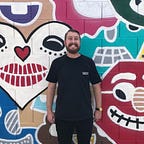Producing A Pizza Podcast
Join me on my journey of creating three episodes of a pizza podcast.
“Hello Pizza People! Welcome to All Things Pizza! where we talk about, you guessed it, all things pizza!” If you’re reading this, you’re obviously not listening to my podcast right now, and I honestly hope you don’t….
In order to learn more about content creation across multiple platforms, I was tasked with creating a three episode podcast of the topic of my choosing. I, being obsessed with pizza, choose to talk about pizza since it’s I topic I know far too much about.
The Process
With my topic in hand, I now needed to determine the content of each of the three episodes. I knew I didn’t want to interview anyone so I would have to fill in the content of each episode on my own. I ultimately decided on three topics that would allow me to create all the content I needed. Next step was to create cover art for the podcast, which you can see in the image above. This was pretty easy to create considering the logo I used was created for a previous project, I simply needed to tweak it to fit the podcast cover art. The image was taken from a group of pictures my wife took for a friends pizzeria in Holladay, UT.
With the cover art created and the episode topics decided, it was time to start gathering content. Pizza has a pretty well known and documented history so it wasn’t very hard to gather everything I needed. Once I had my talking points, it was time to start recording, which is the part I dreaded the most. To keep things simple, I choose to record the audio in Garage Band as well as create my intro/outro music. For the music I took parts from one of my favorite pizza songs, “All I Eat Is Pizza” by Koo Koo Kanga Roo. I have linked the song for your listening pleasure.
Episode 1: The Birth of Neapolitan Pizza as We Know It
This was the first and hardest of the podcast episodes that I recorded. I started out with a simple headset that I use for work and plugged it in to my computer. After recording some test audio, I realized that there was a TON of noise when I played back the audio. After spending time researching how to reduce the noice, I was able to remove it from the silent parts of the audio, but not while I was actually speaking. I then decided to try more of a gaming headset and that fixed the problem entirely.
For this episode, I made a list of all the talking points I wanted to go over. This was a disaster because I was not born to record podcasts and speak on something on the spot. I ended up needing to pause and start my recording multiple times so that I could gather my thoughts and not speak over all my talking points too quickly. After what felt like barely making it through, I ended up with a recording that I thought was just over 5 minutes. More on that later.
Episode 2: A Brief History of Pizza in the US
I learned my lesson from the last recording, and this time came prepared with my ENTIRE episode typed out. This proved to be very helpful. The only thing I had to work out was making sure that I didn’t speak too fast and run out of content. Overall, episode two turned out significantly better.
Episode 3: Pizza in the News — 1
The third and final episode in the series turned out the best, in my opinion. I had my script prepared and felt confident enough to fill in or give additional commentary in places that needed more info. By this time, I had learned my lessons from the first two recordings and was confident in my execution.
Publishing the Podcast
This was honestly the easiest part of the project. I chose Anchor to host my podcast. The process they have up to create a series and upload episodes is very easy. You simply create an account, choose the name of the podcast and enter in a description. You can then either upload the audio or record straight on their site. I obviously chose to upload my audio I previously created. When I uploaded my first episode, it told me it was 16 minutes!? I originally thought I possibly exported it wrong because Garage Band told me it was just over 5 minutes. When I went back to double check, I realized that Garage Band was keeping track of time in Beats, and not actual seconds. So my 300 “second” video was actual 300 beats, which translates to over 16 minutes. Lesson learned. I was then able to easily add the cover art for the series, finish adding the final meta-data for each episode, and publish my content. It was a very simple process that anyone should be able to do in 5 minutes time.
Conclusion
I learned a good amount from this project. I learned the importance of coming prepared to create content. I learned that I am not someone that can just “wing it”. It helped me learn a couple new tools to create content with. I also learned that I never want to record another podcast again. So in conclusion, PLEASE do not listen to my podcast, I probably sound horrible and I’m sure you will be extremely bored after the intro. If you want to admire my cover art and meta-data, go for it.
